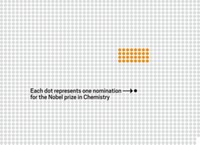Advertisement
Grab your lab coat. Let's get started
Welcome!
Welcome!
Create an account below to get 6 C&EN articles per month, receive newsletters and more - all free.
It seems this is your first time logging in online. Please enter the following information to continue.
As an ACS member you automatically get access to this site. All we need is few more details to create your reading experience.
Not you? Sign in with a different account.
Not you? Sign in with a different account.
ERROR 1
ERROR 1
ERROR 2
ERROR 2
ERROR 2
ERROR 2
ERROR 2
Password and Confirm password must match.
If you have an ACS member number, please enter it here so we can link this account to your membership. (optional)
ERROR 2
ACS values your privacy. By submitting your information, you are gaining access to C&EN and subscribing to our weekly newsletter. We use the information you provide to make your reading experience better, and we will never sell your data to third party members.
Nobel Prize
Leak sheds light on secretive Nobel selection process
Unintended press release about chemistry prize was “likely due to human factor or technical error,” says Swedish Academy spokesperson
by Laurel Oldach
October 6, 2023

The organizations that award the Nobel Prize take secrecy very seriously—so much so that even the identity of nominees is kept under wraps for 50 years. So it came as a surprise when the names of this year’s laureates in chemistry were announced to the Swedish media about 4 h before the announcement of the prize—and before the committee was to meet to make its final selection. An email in Swedish from the Royal Swedish Academy of Sciences naming Moungi Bawendi, Louis Brus, and Alexei Ekimov as the recipients of the 2023 prize was published in the Swedish newspaper Aftonbladet, and English-language news agency Reuters picked up the news.
The leak sheds light on a secretive process. According to the Royal Swedish Academy of Sciences, each September a committee presents a short list of candidates to the academy. The final vote on who should receive the prize, the notification of laureates, and the public announcement all take place on the same day in October. The timestamp on the email distributing the press release, which went to multiple media outlets, was about 2 h before the academy said it would hold its final vote. In response to press inquiries that morning, officials insisted that the laureates had not yet been selected.
The prizes in chemistry, physics, and physiology or medicine are released each year along with extensive materials that must be produced ahead of time: a package for the media that includes images and both high-level and more technical explanations of the award-winning work. The academy’s press spokesperson, Eva Nevelius declined to comment on whether her team had prepared press releases for multiple possible awards or just one.
“It could be that quantum dots were so overwhelmingly popular at those earlier recommendation meetings, the Academy was already drafting everything up and the final vote was a formality. Even so, it’s a big embarrassment for the Royal Swedish Academy of Sciences,” says science journalist Kit Chapman.
During the Nobel press conference, Hans Ellegren, secretary general of the academy, said that the leak, while unfortunate, “did not affect the awarding [of] the prize recipients in any way.” Ellegren and colleagues on the committee insisted that “no decisions are taken until they are taken.”
In an email to C&EN, Nevelius wrote that the leak was “likely due to human factor or technical error. We cannot see that our internal systems have been compromised in any way.” A spokesperson for Meltwater, the public relations wire service that distributed the press release, did not comment on the incident in time for deadline.
Nobel leaks are rare—but, according to Aftonbladet, not unprecedented. In 2010, news that the Nobel Prize in Medicine would go to Robert Edwards got out ahead of the committee’s announcement, apparently after a break-in to a committee member’s car. The Nobel committee brushed off news reports as speculation.




Join the conversation
Contact the reporter
Submit a Letter to the Editor for publication
Engage with us on Twitter